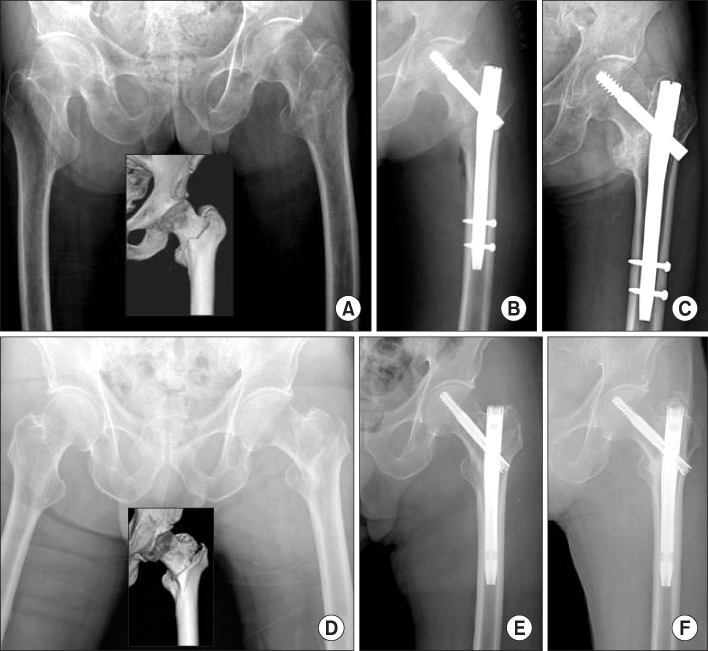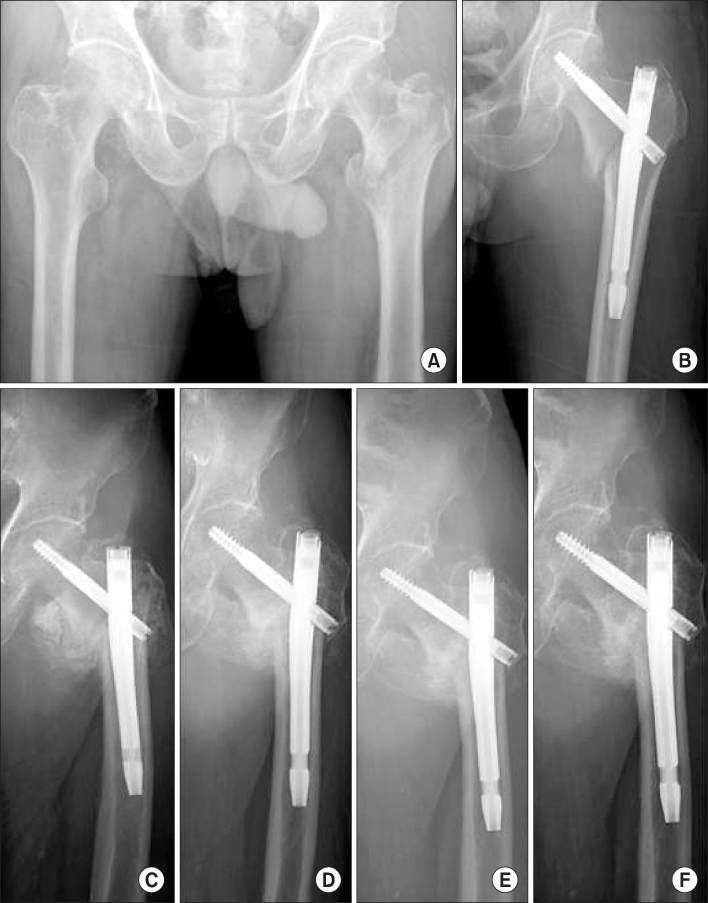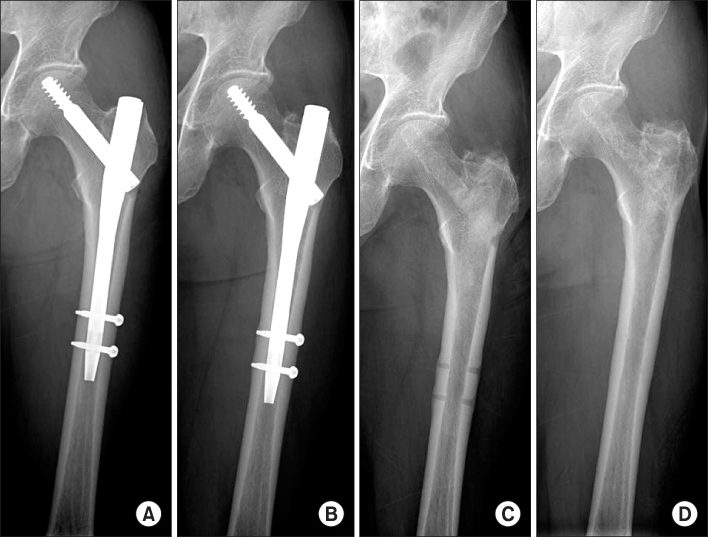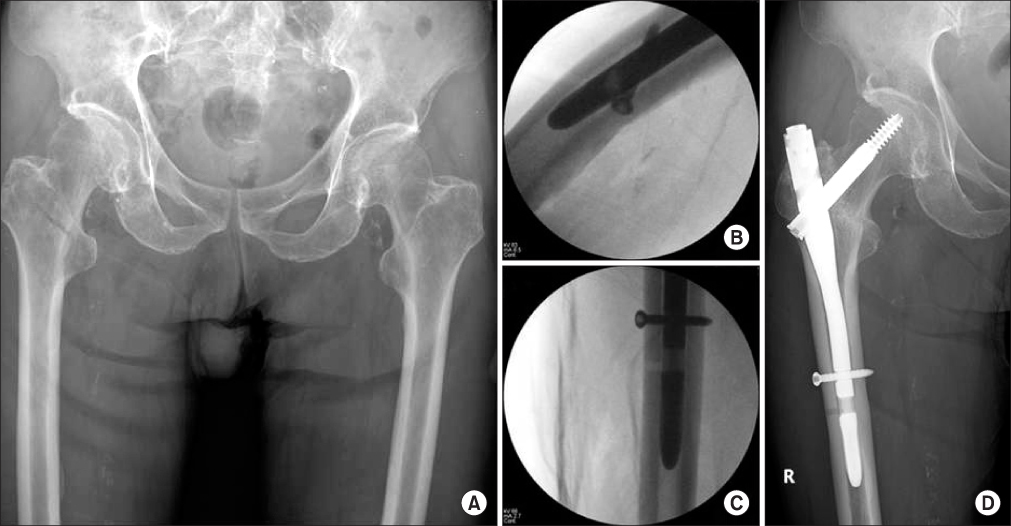J Korean Orthop Assoc.
2015 Feb;50(1):8-17. 10.4055/jkoa.2015.50.1.8.
Is Distal Locking Constantly Necessary When Intertrochanteric Femur Fracture Is Stably Fixed in the Distal Area with Intramedullary Hip Nail?
- Affiliations
-
- 1Department of Orthopedic Surgery, VHS Medical Center, Seoul, Korea. 3188yun@naver.com
- KMID: 2106732
- DOI: http://doi.org/10.4055/jkoa.2015.50.1.8
Abstract
- PURPOSE
The purpose of this study is to investigate the constant necessity of distal locking when intertrochanteric fracture was treated with an intramedullary hip nail.
MATERIALS AND METHODS
From April 2010 to June 2013, 47 stable intertrochanteric fractures (AO/OTA 31-A1) were treated with second generation intramedullary hip nailing. They were followed-up for more than 12 months. In the first group of 18 cases distal locking was used, and in the second group of 29 cases, distal locking was not used. We compared the radiologic and clinical results of the two groups.
RESULTS
Comparison of the two groups of patients showed no difference in terms of radiological and functional results. Postoperative thigh pain developed in eight cases (17%). A statistically difference was observed between isthmic diameter and used nail diameter (Fisher exact test, p=0.01) for postoperative thigh pain. In logistic regression analysis, the difference between isthmic diameter and used nail diameter was the most statistically significant factor in development of postoperative thigh pain (p=0.04, odd ratio=27.75).
CONCLUSION
Our results suggested that the second generation intramedullary hip nail may be successfully implanted without distal interlocking in 31-A1 intertrochanteric femur fracture when the reduction status was satisfactory and stable fixation of the distal area was estimated by less than 3 mm difference between isthmic diameter and used nail diameter.
Figure
Reference
-
1. Cooper C, Campion G, Melton LJ 3rd. Hip fractures in the elderly: a world-wide projection. Osteoporos Int. 1992; 2:285–289.
Article2. Kregor PJ, Obremskey WT, Kreder HJ, Swiontkowski MF. Evidence-Based Orthopaedic Trauma Working Group. Unstable pertrochanteric femoral fractures. J Orthop Trauma. 2005; 19:63–66.
Article3. Cheng T, Zhang G, Zhang X. Review: minimally invasive versus conventional dynamic hip screw fixation in elderly patients with intertrochanteric fractures: a systematic review and meta-analysis. Surg Innov. 2011; 18:99–105.
Article4. Saudan M, Lübbeke A, Sadowski C, Riand N, Stern R, Hoffmeyer P. Pertrochanteric fractures: is there an advantage to an intramedullary nail?: a randomized, prospective study of 206 patients comparing the dynamic hip screw and proximal femoral nail. J Orthop Trauma. 2002; 16:386–393.5. Leung KS, So WS, Shen WY, Hui PW. Gamma nails and dynamic hip screws for peritrochanteric fractures. A randomised prospective study in elderly patients. J Bone Joint Surg Br. 1992; 74:345–351.
Article6. Lacroix H, Arwert H, Snijders CJ, Fontijne WP. Prevention of fracture at the distal locking site of the gamma nail. A biomechanical study. J Bone Joint Surg Br. 1995; 77:274–276.
Article7. Gadegone WM, Salphale YS. Proximal femoral nail: an analysis of 100 cases of proximal femoral fractures with an average follow up of 1 year. Int Orthop. 2007; 31:403–408.8. Radford PJ, Needoff M, Webb JK. A prospective randomised comparison of the dynamic hip screw and the gamma locking nail. J Bone Joint Surg Br. 1993; 75:789–793.
Article9. Rosenblum SF, Zuckerman JD, Kummer FJ, Tam BS. A biomechanical evaluation of the Gamma nail. J Bone Joint Surg Br. 1992; 74:352–357.
Article10. Bridle SH, Patel AD, Bircher M, Calvert PT. Fixation of intertrochanteric fractures of the femur. A randomised prospective comparison of the gamma nail and the dynamic hip screw. J Bone Joint Surg Br. 1991; 73:330–334.
Article11. Skála-Rosenbaum J, Bartonícek J, Bartoska R. Is distal locking with IMHN necessary in every pertrochanteric fracture? Int Orthop. 2010; 34:1041–1047.
Article12. Ozkan K, Unay K, Demircay C, Cakir M, Eceviz E. Distal unlocked proximal femoral intramedullary nailing for intertrochanteric femur fractures. Int Orthop. 2009; 33:1397–1400.
Article13. Doppelt SH. The sliding compression screw: today's best answer for stabilization of intertrochanteric hip fractures. Orthop Clin North Am. 1980; 11:507–523.14. Lindskog DM, Baumgaertner MR. Unstable intertrochanteric hip fractures in the elderly. J Am Acad Orthop Surg. 2004; 12:179–190.
Article15. Cleveland M, Bosworth DM, Thompson FR, Wilson HJ Jr, Ishizuka T. A ten-year analysis of intertrochanteric fractures of the femur. J Bone Joint Surg Am. 1959; 41:1399–1408.
Article16. Fogagnolo F, Kfuri M Jr, Paccola CA. Intramedullary fixation of pertrochanteric hip fractures with the short AO-ASIF proximal femoral nail. Arch Orthop Trauma Surg. 2004; 124:31–37.
Article17. Parker MJ, Palmer CR. A new mobility score for predicting mortality after hip fracture. J Bone Joint Surg Br. 1993; 75:797–798.
Article18. Jensen JS. Determining factors for the mortality following hip fractures. Injury. 1984; 15:411–414.
Article19. Hesse B, Gächter A. Complications following the treatment of trochanteric fractures with the gamma nail. Arch Orthop Trauma Surg. 2004; 124:692–698.
Article20. Grimaldi M, Courvoisier A, Tonetti J, Vouaillat H, Merloz P. Superficial femoral artery injury resulting from intertrochanteric hip fracture fixation by a locked intramedullary nail. Orthop Traumatol Surg Res. 2009; 95:380–382.
Article21. Rajaesparan K, Amin A, Arora S, Walton NP. Pseudoaneurysm of a branch of the profunda femoris artery following distal locking of an intramedullary hip nail: an unusual anatomical location. Hip Int. 2008; 18:231–235.
Article22. Yang KH, Park HW, Park SJ. Pseudoaneurysm of the superficial femoral artery after closed hip nailing with a Gamma nail: report of a case. J Orthop Trauma. 2002; 16:124–127.
Article23. Yang KH, Yoon CS, Park HW, Won JH, Park SJ. Position of the superficial femoral artery in closed hip nailing. Arch Orthop Trauma Surg. 2004; 124:169–172.
Article24. Hardy DC, Descamps PY, Krallis P, et al. Use of an intramedullary hip-screw compared with a compression hip-screw with a plate for intertrochanteric femoral fractures. A prospective, randomized study of one hundred patients. J Bone Joint Surg Am. 1998; 80:618–630.
Article25. Robinson CM, Adams CI, Craig M, Doward W, Clarke MC, Auld J. Implant-related fractures of the femur following hip fracture surgery. J Bone Joint Surg Am. 2002; 84:1116–1122.
Article26. Hardy DC, Drossos K. Slotted intramedullary hip screw nails reduce proximal mechanical unloading. Clin Orthop Relat Res. 2003; 406:176–184.
Article27. Baumgaertner MR, Curtin SL, Lindskog DM. Intramedullary versus extramedullary fixation for the treatment of intertrochanteric hip fractures. Clin Orthop Relat Res. 1998; 348:87–94.
Article28. Xu Y, Geng D, Yang H, Wang X, Zhu G. Treatment of unstable proximal femoral fractures: comparison of the proximal femoral nail antirotation and gamma nail 3. Orthopedics. 2010; 33:473.
Article29. Schipper IB, Steyerberg EW, Castelein RM, et al. Treatment of unstable trochanteric fractures. Randomised comparison of the gamma nail and the proximal femoral nail. J Bone Joint Surg Br. 2004; 86:86–94.30. Park SY, Yang KH, Yoo JH, Yoon HK, Park HW. The treatment of reverse obliquity intertrochanteric fractures with the intramedullary hip nail. J Trauma. 2008; 65:852–857.
Article
- Full Text Links
- Actions
-
Cited
- CITED
-
- Close
- Share
- Similar articles
-
- Nail Breakage after Femoral Interlocking Intramedullary Nailing
- Comparison of Compression Hip Screw, Captured Hip Screw and Gamma-Locking Nail in Intertrochanteric Fracture of Femur
- Removal Methods for Broken Proximal Femoral Nails Using Ball Tip Guide Wire: Technical Note and Two Cases Report
- The Distraction Effect of the Fracture Site on Insertion of the Distal Screw in Interlocking Intramedullary Nailing
- Role of Dynamization in the Interlocking Nailing for Fractures of Femur





